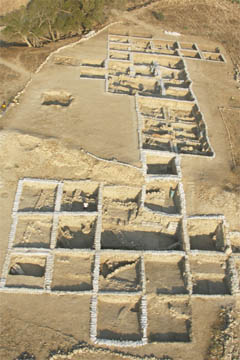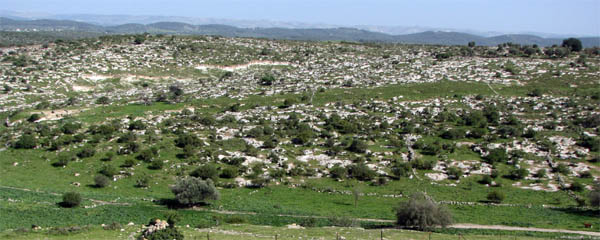Ditch or Moat?
| Tel es-Safi | 31 42 12.47N 34 50 59.70E | You can make out the tel and if you have "Geographic Web" switched on there is a photograph of the ditch just to the east of the high point. A short way to the north is a picture showing the view of the tel from the valley. |
A couple of years ago I was with my father on the Diggings Tour and, after the usual round of pyramids, temples, tombs, Petra and Palestine, we ended up as usual at Beth Govrin for our usual dig. I may have mentioned before that the actual digging leaves me cold: it sounds marvellous in books and magazine articles, but actually getting down and dirty is far less glamorous than the stories imply, with far more dirt and far fewer exciting finds than you might imagine.
Of course, my personal opinion shouldn't prejudice you against trying out the experience. I hate gardening, but I believe there are people never happier than when pottering around in the garden. My father loves digging, so there's no accounting for tastes.
Anyway, the point of the story is that when my father suggested that we utilise one afternoon searchng for Gath I leaped at the opportunity to relieve the boredom of digging. He and I piled into our hire car and headed off up the road. Finding the place would be a piece of cake, according to my father, as he had spoken to one of the people who actually worked on the excavation and had the clearest possible directions.
These turned out to be along the lines of "Turn left at the big junction and it's about five miles on the left."
You will, of course, spot the first problem immediately: what is a "big junction"? Just as one man's exciting dig is another man's boring dirt-shifting, so one man's big junction is another man's barely noticeable side road. So it was on this occasion, where several false starts later we finally decided on a fairly minor junction just past the stream where David found his sling stones and headed up through a national park heading west.
You will not have spotted the second problem, because it isn't there. What our informant failed to mention was that five miles on the left was more like three miles along the main road and then two miles down a wholly insignificant dirt track. We only discovered this minor detail after driving five miles along the main road and five miles back again several times and then asking a chance pedestrian who, by sheer luck, happened to know both the location of Gath and enough English to pass the information on to us.

|
| The excavated area on the summit of Tel es-Safi, neatly divided into squares. |
We headed back for the fourth time, found the aforesaid dirt track and drove our two miles along it to find Tel es-Safi towering above us in a most impressive way. We parked at the foot of the hill on which the tel was sited and scrambled up to the top, from where we had a marvellous view over the surrounding countryside. We couldn't see any remains of the Arab village whose inhabitants had been driven out during the 1948 war, but there were plenty of fields and forestry, signs of modern agriculture.
On the edge of the tel to our left we found the typical squares of a modern excavation, where Professor Aren M. Maeir of Bar-Ilan University has been digging since 1996. His reports claim that the site is one of the most significant in the whole of Israel and the discoveries there throw great light on the period after the death of Solomon when Israel and Judah split into two separate kingdoms. We must allow the good professor a little latitude, for every man thinks his project is the bestest and mostest.
That is not to say that the discoveries have not been interesting. One of the early finds was an ostracon - a piece of pottery on which writing has been scratched or written. In this case someone had scratched the name "Goliath" twice - and considering that the infamous giant slain by shepherd boy David with his sling is supposed to have come from Gath, no one can say that the find lacked interest. Given that the style of writing puts the ostracon around 950 BC, only a few decades after David lived, the find was significant, for it shows that Goliath was a known name in the right place and the right time to lend a degree of credibility to one of the better known Bible stories.
Of course, until we find Goliath's head with a pebble-sized hole in the forehead, we will never be able to "prove" that the story of David and Goliath is true - and even then some of the details will be forever beyond the realm of proof until someone invents a time machine - but at least the find shows that the story is not contradicted by the facts of archaeology.
One reason for our trek on a hot afternoon when we could have been relaxing in the relative coolness of the expedition house at Kibbutz Beit Guvrin was so that we could film on the site and the resulting footage can be viewed in the video "Finds or Frauds" available from this web site. However although we reported the discoveries at Tel es-Safi as honestly and faithfully as we could, it appears that we were wrong on one point.

|
| A view of part of the ditch which surrounds the hill of Tel es-Safi. If you look at the Google Earth reference above, you can make out the ditch on the eastern side of the site. |
Round the bottom of the hill on which the tel is sited there is a ditch, which early reports described as a defensive moat. It is quite a substantial earthwork, 26' wide, 16' deep and over a mile long, and to describe it as a moat was a reasonable deduction. However further work in 2001 led Professor Maeir to date it to Iron Age II and a more mature consideration of the ditch resulted in it being identified, not as a defensive moat but as an offensive siege ditch.
It's all very well sitting down outside a city and waiting for its inhabitants to starve to death, but the blighters will keep objecting to your doing so and swarming out to attack you when and where you least expect it. Digging a deep ditch between you and the city you are besieging is a sensible idea and it would appear that the Arameans - who captured Gath and attacked Jerusalem according to 2 Kings 12:17 - had considered the time and labour invested in digging such an impressive ditch a sound investment.
All of which goes to show that there is always something new being discovered in the Middle East. If you want to participate in the excavations at Gath, Professor Maeir's website is eager to recruit volunteers - though naturally the quality of the experience can never compare with the sheer joy and unadulterated pleasure to be found on the Diggings dig.
© Kendall K. Down 2009





